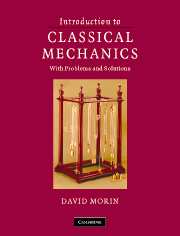Book contents
- Frontmatter
- Contents
- Preface
- 1 Strategies for solving problems
- 2 Statics
- 3 Using F = ma
- 4 Oscillations
- 5 Conservation of energy and momentum
- 6 The Lagrangian method
- 7 Central forces
- 8 Angular momentum, Part I (Constant L^)
- 9 Angular momentum, Part II (General L^)
- 10 Accelerating frames of reference
- 11 Relativity (Kinematics)
- 12 Relativity (Dynamics)
- 13 4-vectors
- 14 General Relativity
- Appendix A Useful formulas
- Appendix B Multivariable, vector calculus
- Appendix C F = ma vs. F = dp/dt
- Appendix D Existence of principal axes
- Appendix E Diagonalizing matrices
- Appendix F Qualitative relativity questions
- Appendix G Derivations of the Lv/c2 result
- Appendix H Resolutions to the twin paradox
- Appendix I Lorentz transformations
- Appendix J Physical constants and data
- References
- Index
10 - Accelerating frames of reference
- Frontmatter
- Contents
- Preface
- 1 Strategies for solving problems
- 2 Statics
- 3 Using F = ma
- 4 Oscillations
- 5 Conservation of energy and momentum
- 6 The Lagrangian method
- 7 Central forces
- 8 Angular momentum, Part I (Constant L^)
- 9 Angular momentum, Part II (General L^)
- 10 Accelerating frames of reference
- 11 Relativity (Kinematics)
- 12 Relativity (Dynamics)
- 13 4-vectors
- 14 General Relativity
- Appendix A Useful formulas
- Appendix B Multivariable, vector calculus
- Appendix C F = ma vs. F = dp/dt
- Appendix D Existence of principal axes
- Appendix E Diagonalizing matrices
- Appendix F Qualitative relativity questions
- Appendix G Derivations of the Lv/c2 result
- Appendix H Resolutions to the twin paradox
- Appendix I Lorentz transformations
- Appendix J Physical constants and data
- References
- Index
Summary
Newton's laws hold only in inertial frames of reference. However, there are many noninertial (that is, accelerating) frames that we might reasonably want to consider, such as elevators, merry-go-rounds, and so on. Is there any possible way to modify Newton's laws so that they hold in noninertial frames, or do we have to give up entirely on F = m a? It turns out that we can in fact hold on to our good friend F = m a, provided that we introduce some new “fictitious” forces. These are forces that a person in the accelerating frame thinks exist. If she applies F = m a while including these new forces, then she will get the correct answer for the acceleration a, as measured with respect to her frame.
To be quantitative about all this, we'll have to spend some time figuring out how the coordinates (and their derivatives) in an accelerating frame relate to those in an inertial frame. But before diving into that, let's look at a simple example that demonstrates the basic idea of fictitious forces.
Example (A train): Imagine that you are standing on a train that is accelerating to the right with acceleration a. If you are to remain at the same spot on the train, then there must be a friction force between the floor and your feet with magnitude Ff = ma, pointing to the right.
- Type
- Chapter
- Information
- Introduction to Classical MechanicsWith Problems and Solutions, pp. 457 - 500Publisher: Cambridge University PressPrint publication year: 2008



